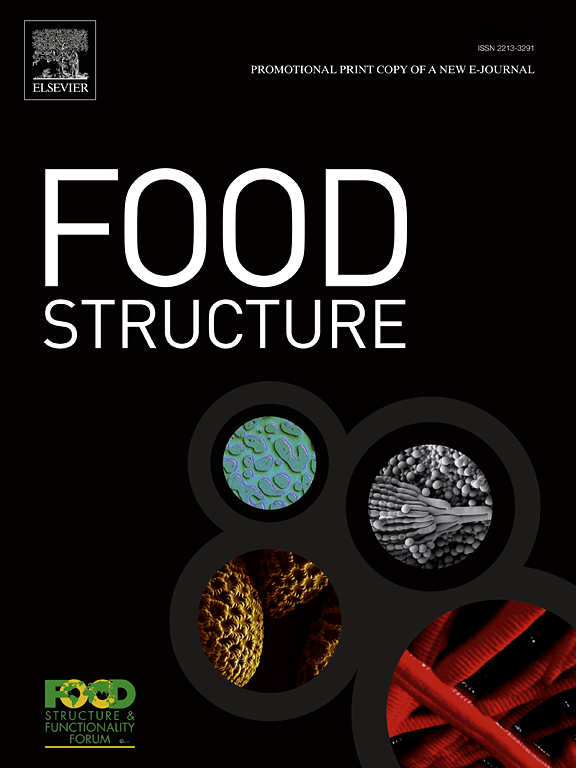研究酶多样性对生产可食用燕窝蛋白水解物的影响:技术功能、结构、分子对接和体外消化率
IF 5.6
3区 农林科学
Q1 FOOD SCIENCE & TECHNOLOGY
引用次数: 0
摘要
本研究在1 ~ 4 h的时间内,研究了胰蛋白酶、木瓜蛋白酶和胃蛋白酶等不同酶对食用燕窝蛋白(EBNP)及其水解产物(EBNPH)的理化、结构和技术功能特性的影响。目的是确定最佳水解条件释放肽和评价其抗氧化活性。据报道,胰蛋白酶产生的水解度(DH)值最高(19.21 %),其次是木瓜蛋白酶(15.6 %)。EBNPH使用胰蛋白酶显示更高的生产能力清除氧化自由基(72.5 ±0.2 %)相比,木瓜蛋白酶(63.7 ±0.3 %)和胃蛋白酶(57.5 ±0.2 %)。此外,明显高于胰蛋白酶证明abt清除活动EBNPH(76.3 ±0.6 %)比木瓜蛋白酶(60.0 ±0.2 %)和胃蛋白酶(67.0 ±0.3 %),表明产生胰蛋白酶EBNPH的最高金额最高的抗氧化活性。此外,FTIR和x射线衍射(XRD)的光谱分析表明,EBNPH具有更高的柔性和迁移率。此外,扫描电镜图像提供了令人信服的证据,证明酶解改善并加速了蛋白质结构的分解。此外,与胰蛋白酶相比,EBNPH更容易被胃蛋白酶(74.15 %)和木瓜蛋白酶(67.83 %)消化,因此胰蛋白酶对EBNPH的消化率显著高于胰蛋白酶(84.14 %)。说明酶修饰有效地提高了水解液的消化率。分子对接研究为糖蛋白与胰蛋白酶相互作用的整个过程提供了全面的解释。因此,上述局部酶解可能会改变EBNP之间的蛋白质构象或EBNP与EBNPH之间的分子间相互作用,从而增强功能,提高食品加工能力。本文章由计算机程序翻译,如有差异,请以英文原文为准。

Investigating the impact of enzyme diversity in producing edible bird nest protein hydrolysates: Techno-functional, structural, molecular docking, and in vitro digestibility
This study investigated the impact of different enzymes, including trypsin, papain, and pepsin, on the physiochemical, structural, and techno-functional characteristics of edible bird’s nest protein (EBNP) and its hydrolysate (EBNPH) over a period of 1–4 h. The aim was to determine the optimal hydrolysis conditions for releasing peptides and evaluate their antioxidant activities. It was reported that trypsin produced the highest degree of hydrolysis (DH) value (19.21 %), followed by papain (15.6 %). EBNPH produced using trypsin showed a higher ability to scavenge oxidizing radicals (72.5 ± 0.2 %) compared to papain (63.7 ± 0.3 %) and pepsin (57.5 ± 0.2 %). Additionally, trypsin demonstrated significantly higher ABTS scavenging activities for EBNPH (76.3 ± 0.6 %) than papain (60.0 ± 0.2 %) and pepsin (67.0 ± 0.3 %), indicating that trypsin produced the highest amount of EBNPH with the highest antioxidant activity. Furthermore, spectral analyses by FTIR and X-ray diffraction (XRD) indicated that a higher flexibility and mobility of the secondary structures had occurred in EBNPH. Moreover, SEM images provide convincing evidence that enzymolysis improves and speeds up the breakdown of proteins’ structures. In addition, EBNPH was more susceptible to digestion by pepsin (74.15 %) and papain (67.83 %) than with trypsin, resulting in significantly higher values for the digestibility of EBNPH with trypsin (84.14 %). This indicates that the enzyme modification effectively improved the digestibility of the hydrolysate. Molecular docking research provides a comprehensive explanation of the entire process of the interaction between a glycoprotein and trypsin. The aforementioned localized enzymolysis, thus, might change protein conformation between EBNP or intermolecular interaction between EBNP and EBNPH to enhance functionality and increase food processing capacity.
求助全文
通过发布文献求助,成功后即可免费获取论文全文。
去求助
来源期刊

Food Structure-Netherlands
Chemical Engineering-Bioengineering
CiteScore
7.20
自引率
0.00%
发文量
48
期刊介绍:
Food Structure is the premier international forum devoted to the publication of high-quality original research on food structure. The focus of this journal is on food structure in the context of its relationship with molecular composition, processing and macroscopic properties (e.g., shelf stability, sensory properties, etc.). Manuscripts that only report qualitative findings and micrographs and that lack sound hypothesis-driven, quantitative structure-function research are not accepted. Significance of the research findings for the food science community and/or industry must also be highlighted.
 求助内容:
求助内容: 应助结果提醒方式:
应助结果提醒方式:


